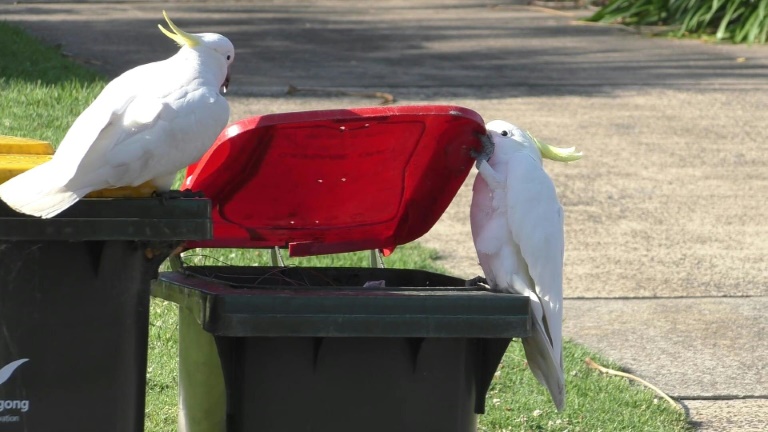
Nothing stops a cockatoo, not even a trash can
Man, in order to acquire new skills, often draws inspiration from more experienced models, such as children observing and reproducing the gestures of the elderly, or amateur athletes who analyze the movements of champions for them.
This proven method also works in cockatoos, according to a study published Thursday in Science, which looks at trash cans in Sydney to document an example of “social learning” in the animal kingdom.
It all started when a scientist from the Australian Museum photographed with his phone a sulfur-tipped cockatoo opening a trash can with its beak and claw to feed on its contents.
“It piqued our interest because it was an innovation and a new way to access resources in the city,” Barbara Klamp of the Max Planck Institute for Animal Behavior told AFP.
The researchers realized that this was a rare opportunity to study the transmission of new knowledge in the animal world.
The parrots’ cousins, known for their towering crests and high intelligence, are “found all over the east coast of Australia and litter boxes are exactly the same everywhere,” which are ideal conditions for a life-size experiment, according to the researcher.
But first, you had to find out if other cockatoos knew how to open up these precious stores.
In an online survey, researchers asked residents of Greater Sydney and the Wollongong (south) region if and when they had witnessed the feat.
Their responses showed that in 2018 cockatoos were caught red-handed in only three neighbourhoods, while by the end of 2019 this practice was observed in 44 of them.
A more detailed analysis confirmed that the technique first spread to the neighborhoods of the first districts, and then spread more and more, which made it possible to rule out chance intervention.
– ‘Local cultures’ –
To better understand this phenomenon, the team took a closer look at cockatoos in action and realized the difficulty of opening the trash when they are winged.
In a certain group, only 10% of these birds succeeded in opening trash cans, while others benefited from the efforts of these “pioneers”.
The most talented maneuver consists of five stages: raising the lid, opening it, closing it, moving toward the hinge to open it wider, and turning it over.
At each step, the researchers noticed differences: some cockatoos opened the lid at the level of the handle, others were closer to the edges, others tilted their heads during handling … The differences were related to geography, with certain techniques very localized in certain areas.
“It showed that there are local subcultures, where there may be local traditions,” says Barbara Clamp.
Such differences have already been observed in other animals, especially in monkeys or whales, whose voices can vary by region, like local dialects.
This study adds a line to the long list of proven talents of cockatoos – who can solve complex puzzles or dance to the beat of music – and demonstrates their adaptability in an urban environment.
But these birds are not only well-made heads, they are also very social.
During the day, they stay in small groups, of about five, but in the evening, they form large groups of 50 to 500 birds. For Barbara Clamp, tips will likely be exchanged in small groups.
“They care about each other, learn from each other and pass on knowledge to each other… It’s interesting to see how they look like us in some ways.”

“Organizer. Social media geek. General communicator. Bacon scholar. Proud pop culture trailblazer.”

